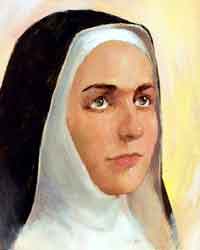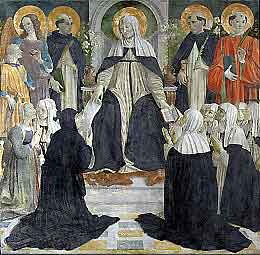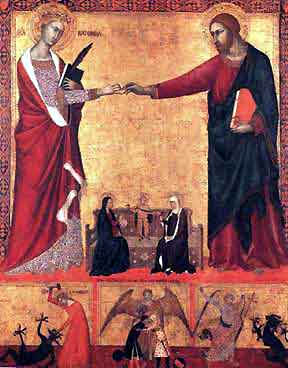|
 St.
Catherine of Sienna St.
Catherine of Sienna
 |
My parents, at times would compare my sister, Cathy, to
her namesake, St. Catherine of Sienna, notbecause she was
so good, but because she was outspoken and blunt. For example,
St. Catherine once called three Italian Cardinals who supported
the anti-pope, "stench that makes the whole world reek."
1
Catherine Benincasa was born on March 25, 1347, in Sienna,
into a world shadowed by such terrible turmoil in the Catholic
Church, today's scandals pale in comparison. During her
lifetime, the Holy See would move to Avignon, and, at her
urgings, return to Rome where it would continue to compete
with an elected anti-pope.
Catherine was the twenty-third child of twenty-four. She
had a twin sister who died at birth. Her father was a dyer
and her mother the practical daughter of a poet, both of
them middle-class citizens. Little Catherine made an impression
with her holiness almost from the time she could toddle.
She had her first vision by the age of six and made sacrifices
while she was still quite young. It is said that, by the
age of seven, Catherine had promised her virginity to God.
However, St. Catherine was no morbid ascetic. Acquaintances,
instead, remember her lively black eyes, her sense of humor,
and her great love for every soul.
Her sacrifices, nevertheless, were perhaps more extreme
than those of any other known saint. She lived for months
at a time on nothing but the Blessed Sacrament. She regularly
scourged herself for love of Jesus and slept as little as
a half hour every other night. St. Catherine, not wanting
to draw attention to herself, would pray to God that He
would make her more like other people. However, her life
was destined to be extraordinary, an example of a life devoted
entirely to Jesus,
Catherine's parents, especially her mother, Lapa, envisioned
a more normal life for their daughter. They wanted her to
marry, and even made her the house slave for three years
as punishment for her refusal to obey then in this matter.
Catherine took this opportunity to see Jesus in every member
of her family, and served them with such unruffled devotion,
that eventually she won first her father over, and then,
years later, her mother.
She became a Dominican Tertiary, meaning that she continued
to live in her own home, while belonging to a Dominican
community of women.
 |
Catherine would have been content to serve God in sacrifice
and prayer, but His will was that she bring about change
in the corrupt Catholic Church. She embraced her mission
with all of the energy she brought to her prayer, tackling
the sinful clergy person by person, winning them over with
the purity of her own life, her direct, firm admonitions
and her own extremely magnetic personality.
It seemed no one could meet her without falling under the
spell of her personal holiness. Priest and bishop would
revile her from a distance, then, upon meeting her face
to face, fall upon their knees, begging forgiveness and
the permission to become her followers.
St. Catherine's body of letters are a telling window to
her person. Most of her letters were dictated to her more
learned disciples, though St. Catherine herself had miraculously
learned to write and read. These letters used none of the
flowery, ethereal language, we might have expected from
a mystic. Instead, St. Catherine writes pointedly and personally,
delineating how each letter's recipient's life had strayed
from the Gospels and what that person needed to do to reform
his or herself. Her frank, yet respectful letters to the
Pope Gregory XI, caused him to forsake his exile in Avignon,
and return to Rome on January 17, 1377. Her learned correspondence
caused her to be named a Doctor of the Church by Pope Paul
VI in 1970.
 |
Among St. Catherine's many ecstasies and visions, was her
mystical marriage to Jesus in 1366. He gave her a wedding
ring during the vision that she wore invisibly for the rest
of her life. Ever after, she dedicated her life to serving
the sick and poor. Catherine also received the stigmata
in 13 65, though the marks were invisible to all until her
death. She requested this boon from Jesus in order to not
draw attention to herself.
Throughout her life, St. Catherine of Sienna suffered horrific
physical pain and ailments, all of which she stood joyfully
for the sake of sinners. She died on April 29, 1380, which
is her Feast Day, at the age of thirty-three, like her beloved
Spouse, Jesus. St. Catherine was canonized in 1461 by Poe
Pius II.
Join us on

|